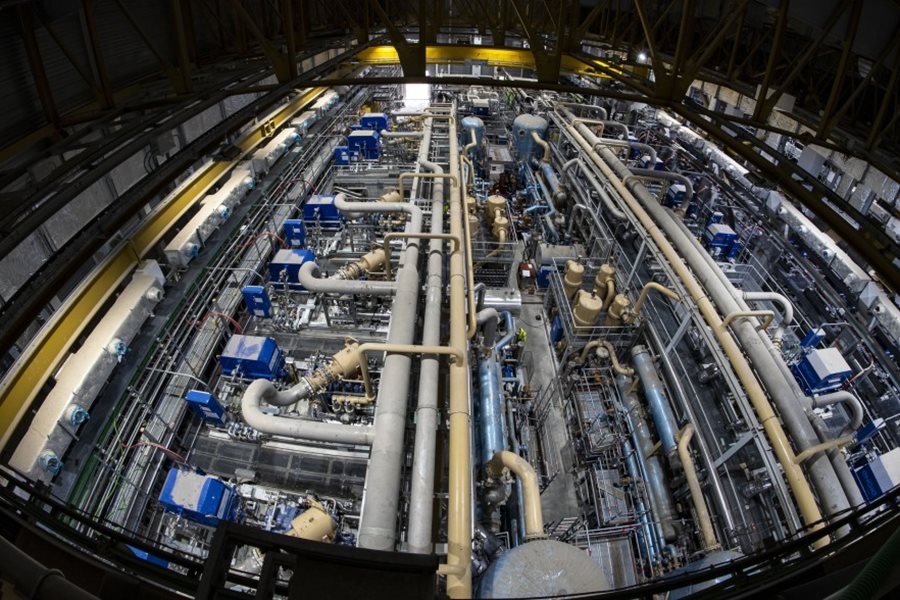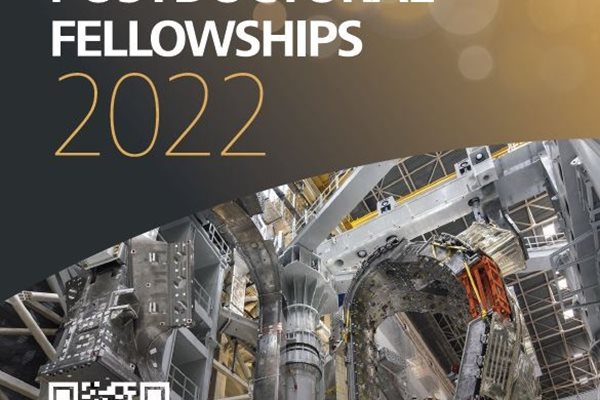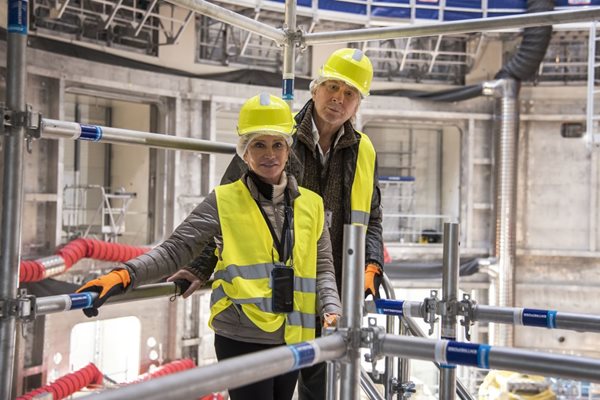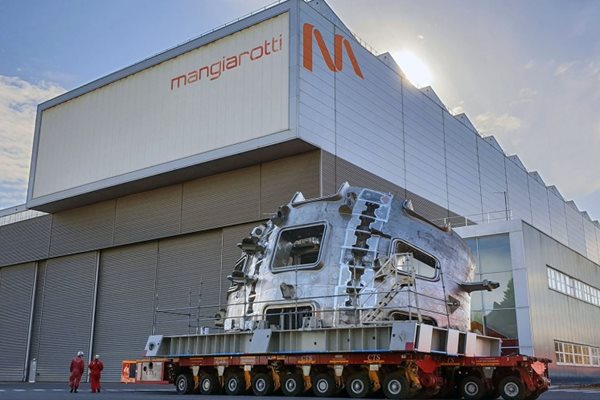
you're currently reading the news digest published from 22 Nov 2021 to 29 Nov 2021
featured4
press10
featured
Cryoplant | First steps toward commissioning
Every week since the beginning of November, a tube trailer filled with approximately 4,600 cubic metres (750 kg) of compressed gaseous helium delivers its load to the ITER cryoplant. At a later stage, the deliveries will become more massive, as helium is delivered in liquid form in 25,000-cubic-metre (4-tonne) cryogenic containers. Progressively, the helium inventory in the cryoplant will reach the volume required to accommodate the different 'clients' inside the tokamak: the lion's share for the superconducting magnets and the cryogenic pumping system, a smaller percentage for the cryostat shielding. Constituting the helium inventory is a decisive step toward the commissioning of the cryoplant installation. 'Over the past three and a half years, we have assembled and installed some 5,000 tonnes of equipment and laid many kilometres of piping—work accomplished through approximately one million work hours and a peak of 200 full-time workers,' explains David Grillot, the head of ITER Cryogenic System Section. 'We are now entering the pre-commissioning phase which includes testing and verifying control-command systems, performing leak tests, and ensuring cleanliness, helium purity and the safety of the equipment.' Like blood in a living organism, helium is at the core of cryoplant operation and performance. 'The helium we receive from the tube trailer is extremely pure—no more than 2 ppm (parts per million) of non-helium molecules. In our processes we must remain below 10 ppm, which means that we must create a vacuum in all our tanks and piping before filling them—what we call the 'helium inerting' process.' Helium is not the only cooling fluid involved in cryoplant operation. In January 2022, special truck trailers will start delivering what will constitute the 'first load' of liquid nitrogen (400,000 litres) to be used as a pre-cooler in the helium cooling process. (During operation phase, an air separation unit will extract nitrogen directly from the air to compensate for the inevitable losses.) The final commissioning sequence of the cryoplant is heavily dependent on the availability of other systems and installations. Compressors, turbines and electrical motors are powerful machines that require considerable cooling power that will only become available when the ITER heat rejection system is fully operational. 'Fortunately, a large part of the pre-commissioning can be done without the availability of cooling water,' smiles Grillot. Likewise, the flow of supercritical helium in the Tokamak Building will need to be tested before all magnets are fully installed. As a consequence, 'bypasses' will be installed to create a closed circuit and verify that the cryogenic system mission can be properly achieved. Operational acceptance testing will begin in the first months of 2022. 'If everything goes well, the cryoplant will be in marching order in 2024,' says Grillot. For the head of the ITER Cryogenic System Section, the adventure will have lasted more than ten years—first as the engineer in charge of design and manufacturing at the French supplier Air Liquide, then at ITER since early 2016. But as always, success will be the result of team work. In the case of the cryoplant, the Cryogenic Integrated Team brings together the three parties sharing responsibility for the procurement of the cryoplant—the ITER Organization, responsible for the liquid helium plant; Europe, in charge of the liquid nitrogen plant and auxiliary systems; and India, whose contractors are procuring the cryolines, the warm lines and cryodistribution components.
Training | Seeking the next group of Monaco-ITER Fellows
Recruitment opens for the next Monaco-ITER Postdoctoral Fellowship campaign on 17 January 2022. If your PhD was awarded after 1 January 2019—or you are about to obtain one—and you are interested in participating in one of the great scientific and technical challenges of the 21st century, this may be an opportunity for you! 'A unique and inspirational environment.' 'Life changing.' 'An atmosphere of excellence.' 'Fun.' These are some of the ways former or current Monaco-ITER Fellows describe their two-year postdoctoral experience at ITER. Working in fusion science or engineering, shoulder-to-shoulder with experts in their domain, Monaco Fellows not only contribute meaningfully to the ITER Project but also gain invaluable professional experience and, in many cases, the chance to participate in the publication of high-quality journal articles in fusion science and technology. The positions are funded by the Principality of Monaco, which signed a Partnership Arrangement with the ITER Organization in 2008 and renewed its sponsorship in 2018 for ten years. Researchers are recruited at the rhythm of five every two years, selected from among applicants from the seven ITER Members or from the Principality of Monaco. Since the start of the program, 35 postdoctoral researchers have benefitted. ITER is seeking top candidates with an excellent track record of creativity and accomplishment. Research possibilities exist in many areas of fusion science and technology, including: Control technology Plasma facing materials and components Burning plasma physics (confinement, stability, plasma-wall interactions, control, energetic particle physics) Heating and current drive physics and technology Fusion plasma diagnostics Superconducting magnet technology Electrical engineering Mechanical engineering/ structural analysis Remote handling technology Vacuum technology and plasma fuelling technology Cryogenics Tokamak operations Tritium breeding and tritium handling technology Thermohydraulics The eighth campaign opens on 17 January 2022 and closes on 1 March 2022. (All Fellows are expected to take up their award on site by 31 December 2022.) The application process will be launched on opening day through the JOBS page of the ITER website; until then, see the Monaco-ITER Fellowships 2022 page for all information. (The 2024 recruitment campaign will open in mid-January 2024.) To advertise the Monaco-ITER postdoctoral fellowship opportunity at your institute, download the 2022 poster here.
Contemporary art | Venet's "arcs" are as heavy as ITER coils
A 'conceptual artist' among the most prominent on the art scene today, Bernar Venet is not impressed by massive towering steel structures like those in the ITER Assembly Hall. Creating massive towering steel structures are his daily routine. Two years ago, in Belgium, the French-born artist who spent most of his career in the United States, unveiled one of his most spectacular works: a 200-tonne, 60-metre-tall 'Arc Majeur' that looks like a giant curved upholstery needle piercing the E411 motorway. Born in Château-Arnoux-Saint-Auban, only 50 kilometres north of ITER, Venet visited the ITER site for the first time on Monday 29 November accompanied by his wife Diane—an art collector specialized in 'artists' jewelry.' What impressed Venet most was not the size of the components being readied for installation in the Tokamak pit, or the 24-metre-in-diameter poloidal field coils currently in fabrication on the ITER site ... but rather the intelligence and creativity that make ITER possible. 'Who are the people who designed such a machine? How did they manage to think about all the details?' At an early stage of his career, Venet explored the artistic potential of equations, graphs, technical drawings, and traces of fundamental particles revealed in bubble chambers. At ITER, he might have found in plasma a source of inspiration for future works.
Image of the week | Final activities on Europe's first sector
The first vacuum vessel sector produced in Europe will arrive at ITER next year. Five of ITER's nine vacuum vessel sectors are the responsibility of Europe's AMW consortium (Ansaldo Nucleare, Westinghouse/Mangiarotti, Walter Tosto, and subcontractors). More than 200 people from seven companies have worked on this European procurement package. Each sector is assembled from four poloidal segments. The four segments for Sector #5—manufactured by different members of the consortium—have now come together on a specialized assembly platform for the final activity phase. In this photo, the 440-tonne sector is seen moving away from the radiographic bunker where tests were carried out; it will now return to the Mangiarotti workshop for the last sequence of activities including outer shell welding. This month, progress on Sector #5 passed the 95.5 percent mark.



